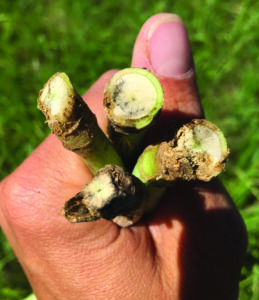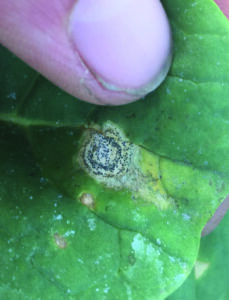Trait makes blackleg resistance more durable
KEY RESULT:
Researchers identified causative genes that provide adult plant resistance (APR) to blackleg. This quantitative trait provides more durable canola resistance against the blackleg pathogen Leptosphaeria maculans, particularly when combined with major race specific (qualitative) resistance genes.
PROJECT TITLE, PRINCIPAL INVESTIGATOR:
“Overcoming blackleg disease in canola through establishment of quantitative resistance,” Hossein Borhan, Agriculture and Agri-Food, Canada Saskatoon
FUNDING:
PUBLISHED ARTICLES:
Read the full report on the Canola Research Hub.
Adult plant resistance (APR) to blackleg is a quantitative trait controlled by multiple genes. Researchers have found APR genes that could increase the durability of canola resistance to blackleg pathogen Leptosphaeria maculans.
Researchers took advantage of the well-defined canola population that was created by crossing the B. napus cultivar Castle, which has APR to blackleg, and the B. napus cultivar Topas, which does not, to identify the quantitative trait locus (QTL) for blackleg resistance (BL-QTL). Unlike qualitative traits that are often controlled by single genes, QTLs such as crop yield are controlled by multiple genes.

Photo Credit: Justine Cornelson
Researchers developed a growth chamber APR screening method and tested the progenies of the Castle-Topas population for APR against blackleg. They identified a quantitative disease resistance trait and a major QTL locus candidate, named BL-QTL1 located on chromosome A08. This was the only QTL identified under the growth chamber APR assay and was also the most significant QTL under field conditions.
Building on previous APR genotyping efforts, the objectives of this four-year project were to identify and accurately map QTLs controlling APR, clone the QTLs, develop and test APR markers and understand the function and downstream pathways of APR.
Under growth chamber conditions, accurate mapping of QTLs combined with RNA-sequencing of individual progenies during response to L. maculans infection resulted in identification of several QTLs. Combining the mapping and gene expression data helped to identify several candidate QTLs with a high probability of controlling the APR response.
Researchers also evaluated BL-QTL performance under field conditions, and tested 53 spring type B. napus lines with a potentially functional BL-QTL1 trait in a blackleg field nursery in Alberta. Tests comparing 25 plants for each line in randomized replicated blocks. B. napus Castle and Westar, with and without APR respectively, were the controls.

At the end of growing season, researchers scored stem lesions on a 0 to 5 scale. Eleven lines showed APR to the same level or better than Castle, while in 18 lines the size of stem lesions was equal to or less than 60 per cent of the lesion size recorded for Westar.
As a result of the project, the discovery of quantitative resistance QTLs against blackleg, including the significant Bl-QTL1, is an important first step in understanding the molecular mechanism of QTL resistance. Canola breeders could use marker assisted selection to choose lines with this trait.
Going forward researchers will continue to investigate how to successfully apply the outcome of this research in designing canola cultivars with durable resistance to blackleg.





